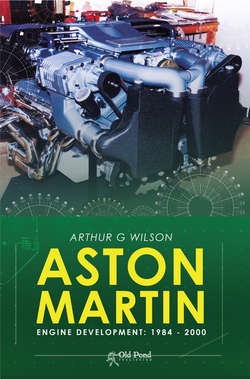Aston Martin Engine Development: 1984-2000

Реклама. ООО «ЛитРес», ИНН: 7719571260.
Оглавление
Arthur Wilson L.. Aston Martin Engine Development: 1984-2000
Aston Martin. Engine Development
Contents
Foreword by David Morgan
Author’s Preface
London Brick Co to Aston Martin Lagonda
Starting at Aston Martin Lagonda
Experimental Department
DP1054
V12 Engine. DP1080
Aston Martin Tickford
AML Engineering Department, 1984
Changing Times
Engineering Directors
Engineers
Fairly Secret Engines
Engine Development Test Bed
1984 Engine Status
Vantage 580X
Four Valves Per Cylinder
Callaway Engineering
32-Valve Engine Development
Air Filters
Exhaust
Camshafts and Compression Ratio
In-House Manufacture
Engine Finish
1987 Vantage
Vantage Target Objectives
Power and Torque
Bhp/Litre/Rpm
Normal Aspirated
Why Supercharging?
Turbo Supercharging
Exhaust Gas-Driven Turbocharging
Power Delivery
Engine Driven Supercharging
Engine Design Implications
Supercharger Installation
Engine Management
Base Engine Preparation
Cylinder Head Development
Combustion Chamber
Cylinder Head Casting
Cylinder Head Durability Testing
Coolant Flow
Cylinder Block Changes
Crankshaft
Crankshaft Bearing Loads
Conn Rods
Pistons
Gaskets
Supercharger System Belt Drive
Catalysts
Spark Plugs
Camshaft
Lubrication
Exhaust Gas and Noise Emissions
200 mph
Further Development
Footnote
Last Days
Engine Oil Sample
A Photo Record of the Last Days of Engine Manufacture at Newport Pagnell
Отрывок из книги
Aston Martin
Engine Development
.....
Initially I would concentrate on three positions, zero, 4.6 and 50.5 degrees on the metering unit. Zero, 2.5 and 40 degrees throttle respectively. If these positions are correct then all other check positions should fall into place.
Ensure that all pointers read zero and that throttles are closed on the stops with no free play and also that the metering unit is on its closed stop. Adjust the throttle setting tool via the knurled nut to open the throttle to 4.6 degrees metering unit and 2.5 degrees throttle. If this is not correct, recheck the zero setting and also that all three pointers start to move at the same time. Continue to open the throttle to give 50.5 degrees on the metering unit. The throttle indicator pointer should show that both throttles are 40 degrees open. If this is not so, release the lock nuts and adjust the double-ended (left- and right-hand thread) throttle rods, each side to double the error (i.e., if the reading is 42 degrees then double this to read 44 degrees, or if 38 degrees adjust to 36 degrees, and retighten the lock nuts). Adjust the tool to return the metering unit to zero on its closed stop and release the clamp bolt on the outer throttle levers and reset the throttles to zero on the stops, with no free play.
.....